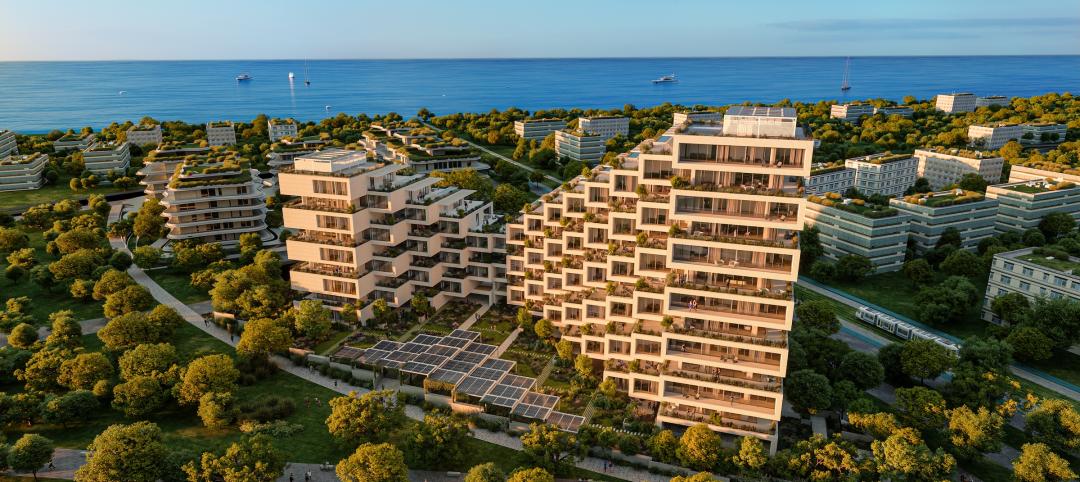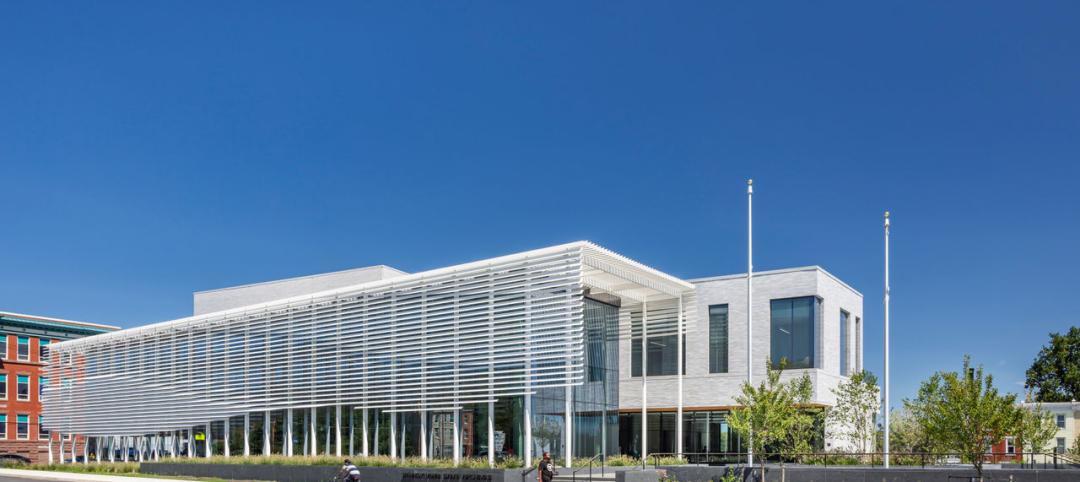Building Teams and their clients tend to think of a decorative concrete contractor as just another trade to be fit into the construction schedule, preferably at the lowest possible cost. But installing decorative concrete can be a delicate process, making planning for the construction crucially important.
At one time, decorative concrete came in only a few finishes—colored concrete, acid-etch stained, and stamped patterns. Today, there’s an almost infinite number of finishes available for horizontal and vertical surfaces—stamped, textured, integral and dust-on, colored, acid etch, dye (water and solvent), stampable overlays, self-level overlays, micro-toppings, stencil, engraved, form liners, diamond polished, sandblast, exposed aggregate, and coatings (epoxy, urethane, and acrylic). Finishes can also be combined with other finishes.
The possibilities are limited only by creativity of the designer and concrete contractor, yet it’s that very creativity that makes using decorative concrete so attractive. The problem is that concrete is very sensitive to a wide range of variables that can negatively impact the outcome.
ALSO SEE: 8 Innovations That Will Rock Your Next Concrete Project
To learn more about how to control these variables and thereby make decorative concrete a successful component of your next project, we consulted Mike Miller, Managing Principal of The concretist, Benicia, Calif. (www.theconcretist.com), one of the oldest decorative concrete contractors in the business. The term “concretist” refers to “one who practices concrete poetry,” and Miller himself is widely known for the almost poetic nature of his work.
1. Correctly assess—and manage—client expectations.
Miller says projects should start with the owner providing a full description, preferably in writing, of what the finished product should look like. Then the contractor can respond with what’s physically, aesthetically, and financially feasible. Sometimes owners have unreasonable expectations; early discussion can help manage those expectations.
What Building Teams should do when specifying decorative concrete:
1. Correctly assess—and manage—client expectations.
2. Choose the right decorative concrete contractor.
3. Carefully schedule the work of other trades to avoid undue damage to the concrete.
4. Provide the right protection for the finished work.
5. Negotiate an agreement with the client/owner on post-occupancy maintenance.
Decorative concrete usually isn’t structural in nature, although specifications are often written as if they were. For instance, a specification might require concrete with high compressive, tensile, or flexural strengths cured in a prescriptive manner. Or a specification might require “green concrete” with a certain percentage of the portland cement substituted with fly ash, slag cement, or other pozzolanic materials.
Miller’s advice: Focus first on the requirements for a good decorative installation; otherwise the work might meet all the structural requirements but be rejected for aesthetic reasons. For example, applying the usual curing specification for plain concrete to decorative work could have disastrous results, to the point of permanently damaging the look of decorative work. He urges Building Teams to use pre-job conferences to focus on the “dryness” of concrete or the slab relative humidity needed to start finish work rather than how to retain more moisture for curing purposes.
2. Choose the right decorative concrete contractor.
There can be significant variations in the creative abilities of decorative concrete contractors, says Miller. If you want highly creative work you must find a contractor who can perform at that level and who also possesses good craft skills. Contractors tend to specialize in certain types of decorative concrete these days, so you’ll have to narrow your search to get the right one for your job.
A word of caution: Miller says some decorative concrete contractors don’t place-and-finish concrete and wouldn’t know how to do it if asked, so you might have to hire a place-and-finish concrete contractor in addition to a decorative specialist.
3. Carefully schedule the work of other trades to avoid undue damage to the concrete.
Unfortunately, decorative concrete is highly susceptible to damage by other trades, more so than tile or other finished floor surfaces. Damage to concrete slabs can occur before decorative work begins or afterwards. Plumbers have been known to spill cutting oil, hot solder, and plastic pipe glue on slabs. Carpenters seem to think that any flat surface was put there so that they could pile stacks of lumber on it. Even trade workers’ footprints on floors that are hard but still considered “green” can become visible when acid-stain finishes are applied. Shoe soles also contain oils that may act as a resist.
To avoid conflicts with other trades, Miller recommends scheduling this work starting on a Friday afternoon and proceeding through a weekend. With no one on the job site to cause problems or delays, he says that’s the best chance for success.
4. Provide the right protection for the finished work.
The common belief about concrete is that it gets hard, becomes even stronger over time, and that’s pretty much it—no need to worry further. But that is not the case. Concrete remains vulnerable because its chemistry continues to change as it ages, and water on slab surfaces can bring about other physical and chemical changes. That’s why it’s so important to include a plan for protecting the finished work in pre-job meeting discussions.
Miller says covering material must allow moisture vapor from concrete to pass through while not allowing products that can stain to reach the surface of the concrete. The responsibility for the finished work is not a trivial matter. Since the concrete contractor cannot be expected to stay on the job until the concrete has fully cured, the responsibility for protecting the decorative work falls to the general contractor. However, that does not absolve the decorative contractor of all responsibility. The subcontractor should suggest the best protective products to use and perhaps even install them the first time.
5. Negotiate an agreement with the client/owner on post-occupancy maintenance.
A long-term maintenance plan should be part of the discussion your Building Team has with the client and facilities staff before construction begins. There are several ways to seal decorative work; each sealer provides a unique appearance. If an owner wants a glossy “wet look,” an epoxy, polyaspartic urethane, or acrylic finish is a good choice. These finishes must be renewed per the manufacturer’s recommendation. The accepted standard is that pedestrians should walk on the sealer, not on the concrete.
ALSO SEE: The world’s first building made from carbon-fiber reinforced concrete starts construction in Germany
If the owner wants a natural concrete look without a glossy appearance, there are penetrating sealers on the market that restrict pore openings so that dirt and other staining materials will not penetrate the surface.
Diamond-polished floors present additional maintenance problems. Owners typically want these floors to have a high-gloss shine, but dirt and fine grit become abrasive under foot traffic, dulling the surface gloss over time. Some big-box retail companies have maintenance programs to remove dirt and grit on a frequent schedule. In grocery stores food spillage must also be removed and cleaned as it occurs.
The inspirational aspect of decorative concrete
There are good reasons for the growing popularity of decorative concrete. It’s in our nature as humans to surround ourselves with creative expression and color; we like to be emotionally pleased by our environment.
Today, there are many more options for Building Teams to provide that kind of satisfaction through the use of decorative concrete. That’s why it’s important for Building Teams to work with their decorative concrete contractors to meet these heightened client expectations and ensure a long and useful life for these beautiful, inspiring surfaces. +
--
Joe Navsik, a freelance writer in the Chicago area, is a former editor at Concrete Construction magazine.
Related Stories
Codes and Standards | Jan 8, 2024
Australia to be first country to ban engineered stone countertops
In 2024, Australia will be the first country to ban engineered stone countertops. The ban came after a years-long campaign supported by doctors, trade unions, and workers over concerns that the material was causing increased silicosis cases among workers cutting and handling it.
Roofing | Jan 8, 2024
Researchers devise adaptive roof tile concept that adjusts to ambient temperatures
Scientists at the University of California Santa Barbara published a paper that proposes adaptive roof tile technology that can adjust to ambient temperatures. Using a wax motor, tiles could switch from a heating or cooling state enabling savings on heating and cooling costs.
MFPRO+ News | Jan 4, 2024
Bjarke Ingels's curved residential high-rise will anchor a massive urban regeneration project in Greece
In Athens, Greece, Lamda Development has launched Little Athens, the newest residential neighborhood at the Ellinikon, a multiuse development billed as a smart city. Bjarke Ingels Group's 50-meter Park Rise building will serve as Little Athens’ centerpiece.
Resiliency | Jan 2, 2024
Americans are migrating from areas of high flood risk
Americans are abandoning areas of high flood risk in significant numbers, according to research by the First Street Foundation. Climate Abandonment Areas account for more than 818,000 Census Blocks and lost a total of 3.2 million-plus residents due to flooding from 2000 to 2020, the study found.
MFPRO+ News | Jan 2, 2024
New York City will slash regulations on housing projects
New York City Mayor Eric Adams is expected to cut red tape to make it easier and less costly to build housing projects in the city. Adams would exempt projects with fewer than 175 units in low-density residential areas and those with fewer than 250 units in commercial, manufacturing, and medium- and high-density residential areas from environmental review.
Contractors | Dec 22, 2023
DBIA releases two free DEI resources for AEC firms
The Design-Build Institute of America (DBIA) has released two new resources offering guidance and provisions on diversity, equity, and inclusion (DEI) on design-build projects.
MFPRO+ News | Dec 22, 2023
Document offers guidance on heat pump deployment for multifamily housing
ICAST (International Center for Appropriate and Sustainable Technology) has released a resource guide to help multifamily owners and managers, policymakers, utilities, energy efficiency program implementers, and others advance the deployment of VHE heat pump HVAC and water heaters in multifamily housing.
Sustainability | Dec 22, 2023
WSP unveils scenario-planning online game
WSP has released a scenario-planning online game to help organizations achieve sustainable development goals while expanding awareness about climate change.
Healthcare Facilities | Dec 19, 2023
A new hospital in Duluth, Minn., is now the region’s largest healthcare facility
In Duluth, Minn., the new St. Mary’s Medical Center, designed by EwingCole, is now the largest healthcare facility in the region. The hospital consolidates Essentia Health’s healthcare services under one roof. At about 1 million sf spanning two city blocks, St. Mary’s overlooks Lake Superior, providing views on almost every floor of the world’s largest freshwater lake.
Government Buildings | Dec 19, 2023
New Pennsylvania State Archives building holds documents dating back to 1680
Work was recently completed on a new Pennsylvania State Archives building in Harrisburg, Penn. The HGA-designed, 146,000-sf facility offers numerous amenities, including computers, scanners, printers, a kitchenette with seating, lockers, a meeting room, a classroom, an interactive video wall, gallery, and all-gender restrooms. The features are all intended to provide a welcoming and comfortable environment for visitors.

















